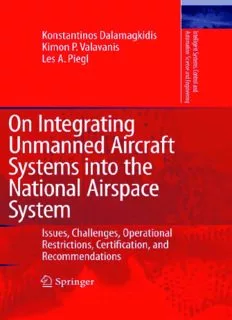Table Of ContentOn Integrating Unmanned Aircraft Systems
into the National Airspace System
International Serieson
INTELLIGENTSYSTEMS, CONTROL, AND AUTOMATION:
SCIENCE ANDENGINEERING
VOLUME36
Editor
ProfessorS.G.Tzafestas,NationalTechnicalUniversityofAthens,Greece
EditorialAdvisoryBoard
ProfessorP.Antsaklis,UniversityofNotreDame,IN,U.S.A.
ProfessorP.Borne,EcoleCentraledeLille,France
ProfessorD.G.Caldwell,UniversityofSalford,U.K.
ProfessorC.S.Chen,UniversityofAkron,Ohio,U.S.A.
ProfessorT.Fukuda,NagoyaUniversity,Japan
ProfessorF.Harashima, UniversityofTokyo,Tokyo,Japan
ProfessorS.Monaco,UniversityLaSapienza,Rome,Italy
ProfessorG.Schmidt,TechnicalUniversityofMunich, Germany
ProfessorN.K.Sinha,McMasterUniversity, Hamilton,Ontario,Canada
ProfessorD.Tabak,GeorgeMasonUniversity, Fairfax,Virginia, U.S.A.
ProfessorK.Valavanis, UniversityofDenver,U.S.A.
Forothertitlespublishedinthisseries,goto
http://www.springer.com/series/6259
. .
K.Dalamagkidis K.P. Valavanis L.A. Piegl
On Integrating Unmanned
Aircraft Systems into
the National Airspace System
Issues, Challenges, Operational Restrictions,
Certification, and Recommendations
(cid:65)(cid:66)(cid:67)
Konstantinos Dalamagkidis Kimon P. Valavanis
University of South Florida University of Denver
Department of Computer Science Department of Electrical and Computer Engineering
and Engineering Clarence M. Knudson Hall
4202 E. Fowler Ave. 2390 S. York Street
Tampa FL 33620 Denver CO 80208
USA USA
konstantinos@dalamagkidis.info kimon.valavanis@du.edu
Dr. Les. A. Piegl
University of South Florida
Department of Computer Science
and Engineering
4202 E. Fowler Ave.
Tampa FL 33620
USA
lap@cse.usf.edu
ISBN 978-1-4020-8671-7 e-ISBN 978-1-4020-8672-4
LibraryofCongressControlNumber:2008935507
©2009 SpringerScience+BusinessMedia,B.V.
Nopartofthisworkmaybereproduced,storedinaretrievalsystem,ortransmittedinanyformorby
anymeans,electronic,mechanical,photocopying,microfilming,recordingorotherwise,withoutwritten
permissionfromthePublisher,withtheexceptionofanymaterialsuppliedspecificallyforthepurpose
ofbeingenteredandexecutedonacomputersystem,forexclusiveusebythepurchaserofthework.
Printedonacid-freepaper
987654321
springer.com
Tomyfamily,andthefriendswhohave
helpedmeretainmysanity overtheyears.
KonstantinosDalamagkidis
ToStellitsaandPanoulis,mykids.
KimonP.Valavanis
Dedicatedtomylovingwife,Kae.
LesA.Piegl
Foreword
WhenfirstaskedbyKimontowriteaforewordtothismonographIfelthonoredto
beselectedandbeganmyreviewofthemanuscriptwithaneyetoitspotentialcon-
tributiontotheUASindustrywhichiscurrentlytryingtogainaccesstotheNational
AirspaceSystem.DuetothenatureofthedocumentIsoonfoundmyselfconflicted
onpreciselywhatthecontributionmightultimatelybe.Onegoalofthispublication
it appeared was to establish a baseline summary of the state of the industry from
airframe/power-plantvariabilityandhencemissioncomplexityperspective. Italso
organizedcriticallyimportantinformationrelatedtotheUnitedStatesandInterna-
tionalregulatorystatusandledtosuggestionsregardinghowtoovercomeremaining
hurdles.This,theauthorshaveorganizedverypreciselyandplacethedocumentin
a position for periodic review on regulatory progress. As the results of the current
Aviation Rule Committee addressing Small UAS Airworthiness Certification and
Operational considerations (sUAS ARC), these results can easily be incorporated
intoaddendaormanuscriptrevisions.
Another key contribution is the review of UAS flight safety from the perspec-
tive of risk (which is defined in early on) one component of which is the level of
damagebyimpactonthegroundcoupledwiththelikelihoodofaneventhappening
(probabilityofoccurrence),andparsedwithrespecttoflightoverareasofvarying
populationdensity.Thiswasthefirstcomprehensiveanalysisofrisksincethesemi-
nalstudiesbyRolandWeibelandDr.JimHansmanofMIT.Theproblemisthatthis
industryhasnomechanismyet,istooimmature,tohavededicatedpeerreviewpro-
cessesassociatedwithstandardjournals.Whatweightorsignificancethencanwe
applytothedataandinterpretation/analysisthattheauthorshavebroughtforward?
I took it upon myself, on an ad hoc basis, to ask industry colleagues to review
the manuscript, and the scientific papers presented at conference by Kimon and
Konstantinos,whichareusedasabasisforthedatapresented,andtoprovidefeed-
backaddressingthevalidityofassumptions,models,thedataparadigmandworkup
inessencea“poormanspeerreview”.
Severalauthoritiesweighedinwithcommentsandsuggestions.Iampleasedto
reportthatthereviewersreportnosignificantissueswiththedatamodelsandexper-
imentalparadigmused.Thisissignificantbecausethereporteddataindicatethatthe
vii
viii Foreword
earlierdataandanalysisbytheMITgroupwas“overlyconservative”andUASsof
varyingweightclasses,wouldposelessriskthatwhathasbeenreportedbyearlier
studies.(Ihadintendedtonamethereviewersinthespiritoffulldisclosure,how-
everregrettably,publishingdeadlinesinterferedwithmyabilitytogetpermissionto
includenamesandalsotoacquirepermissionfromtheiremployerstobequoted.)
Further,thedatacontainedwithinhasbeensubmittedtoseveralmembersinthe
leadershipofthesUASARCanditishopedthatitwillbegivendueconsideration
as the ARC reports in with it’s suggested guidance to the FAA as it promulgates
sUASsafetyregulationsbeginningwithsmallUASs.
In general I am very pleased that Kimon and his colleagues have put this sum-
marydocumenttogetherfortheUAScommunityandIlookforwardtosemiannual
orannualupdatedtowhatmaybecomeanongoing,living,compilationoftheUAS
StateoftheIndustry.
OysterBay,NY,September2008 JamesE.Jewell
PresidentUAVMarketSpaceInc.
ASTMF38UASExecutiveCommitteeMembershipSecretary
Preface
UnmannedAircraftSystems(UAS)researchanddevelopmentandprocurement,as
wellasdiverseUASrelatedactivitiesareincreasingrapidly,worldwide.UAShave
seenunprecedentedlevelsofgrowthonallfrontsoverthepast10years;however,
thebestisyettocome!
Whathasbeenanamazingfactisthatalthoughin1997thetotalincomeofthe
Unmanned Aerial Vehicle (UAV) global market was about $2.27 billion,1 it has
beenarguedthatuntil2015theUAVmarketintheUS,asawhole,willreach$16
billion,withEuropeasacontinentplayingtheroleofthesecondbutdistantcom-
petitor, spending just about 2 billion.2 However, a study conducted by the Teal
e
Group3 claims that UAVs will continue to be the most dynamic growth sector of
the world aerospace industry, estimating that UAV spending will more than triple
over the next decade, totaling close to $55 billion. An interesting conclusion that
theTealGroupreachedwasthatthecivilUAVmarketwillslowlyemergeoverthe
nextdecade,startingfirstwithgovernmentorganizationsrequiringsurveillancesys-
temssimilartomilitaryUAVssuchascoastguards,borderpatrolorganizationsand
similarnationalsecurityorganizations.
Surprisinglyenough,itisthisconclusionthat,coupledwithmajorinitiativesto
pushforcivilianandpublicuseUAS,motivatedtheauthorstowritethisbook.The
motivation and rationale becomes more than obvious when one considers that uti-
lizationofUASforcivilianapplicationsrequiresthattheyflyincivilian,restricted,
space,thatis,itrequiresthatUASbeintegratedintotheNationalAirspaceSystem
(NAS)ofthecountryorcontinenttheyflyover.
The challenge is huge because all that is available today, worldwide, reflects
mannedaviation.Effortsbynationalandinternationalorganizationstoproduceand
develop rules, regulations, procedures and standards for integration of UAS in to
1 “WorldMarketsforMilitary,CivilandCommercialUAVs:ReconnaissanceUAVsandAerial
Targets”,FrostandSullivan,1998.
2DickersonL.,“UAVsontheRise”,AviationWeek&SpaceTechnology,AerospaceSourceBook
2007,Vol.166,No.3,2007.
3http://www.roboticstrends.com/displayarticle880.html,09/06,RoboticsTrends.
ix
x Preface
the national airspace are on the rise, but, development of a detailed and complete
roadmapisfarfrombeingcomplete.
In essence, integration of UAS in the NAS will depend, among other things,
on whether UAS achieve, at a minimum, an equivalent level of safety to that of
mannedaviation.Thissafetylevelisdefinedprimarilyintermsoftheriskposedby
UASoperationstohumanlifeeventhoughotherpotentialcollateraldamagemaybe
takenintoaccount.
Theauthorshopethatthisproject,beingfarfromcomplete,willserveasarefer-
encetext,perhapsausefultool,whichlaysthefoundationforwhatneedsbedone
inordertoarriveatthedesiredoutcome:integratedmannedandunmannedaviation
flyinginthesameairspace.
Assuch,currentmannedaviationregulationsarereviewed,followedbyavailable
unmannedaviationregulationsworldwide.UASsafetyassessmentsandfunctional
requirements are presented, which lead to derivation of equivalent levels of safety
based on those used for manned aviation. Recommendations for a roadmap that
leadstoUASintegrationintothenationalairspacesystemarealsopresented.
Last, but not least, it is expected that as the field matures and the roadmap is
moreconcrete,thisbookwillbeupdatedinordertoserveasa‘referencemanual’
or‘handbook’.
Tampa,FL KonstantinosDalamagkidis
September2008 KimonP.Valavanis
LesA.Piegl
Description:Commercial interest for unmanned aircraft systems (UAS) has seen a steady increase over the last decade. Nevertheless, UAS operations have remained almost exclusively military. This is mainly due to the lack of a regulatory framework that allows only limited public and civil UAS operations with usua

